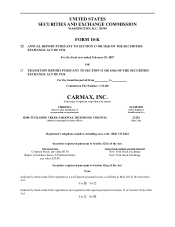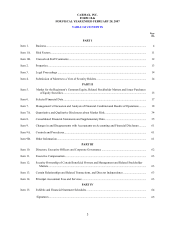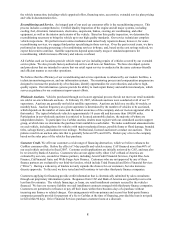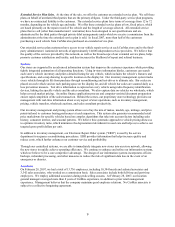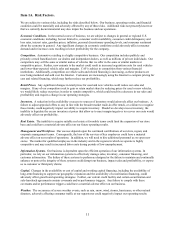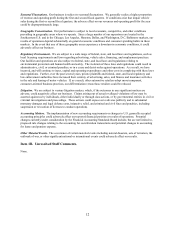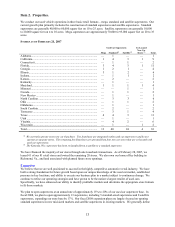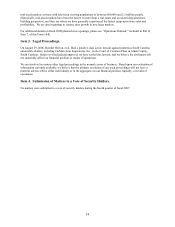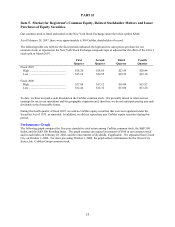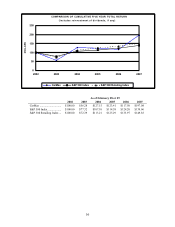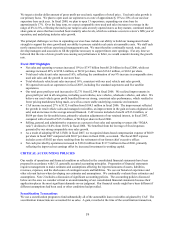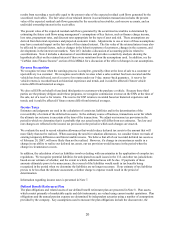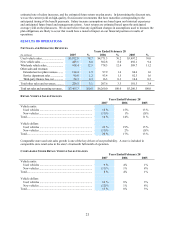CarMax 2007 Annual Report Download - page 21
Download and view the complete annual report
Please find page 21 of the 2007 CarMax annual report below. You can navigate through the pages in the report by either clicking on the pages listed below, or by using the keyword search tool below to find specific information within the annual report.11
Item 1A. Risk Factors.
We are subject to various risks, including the risks described below. Our business, operating results, and financial
condition could be materially and adversely affected by any of these risks. Additional risks not presently known or
that we currently deem immaterial may also impair the business and our operations.
Economic Conditions. In the normal course of business, we are subject to changes in general or regional U.S.
economic conditions, including, but not limited to, consumer credit availability, consumer credit delinquency and
loss rates, interest rates, gasoline prices, inflation, personal discretionary spending levels, and consumer sentiment
about the economy in general. Any significant changes in economic conditions could adversely affect consumer
demand and/or increase costs resulting in lower profitability for the company.
Competition. Automotive retailing is a highly competitive business. Our competition includes publicly and
privately owned franchised new car dealers and independent dealers, as well as millions of private individuals. Our
competitors may sell the same or similar makes of vehicles that we offer in the same or similar markets at
competitive prices. Further, new entrants to the market could result in increased acquisition costs for used vehicles
and lower-than-expected vehicle sales and margins. CAF is subject to competition from various financial
institutions. Additionally, competition on vehicle sales and related financing is increasing, as these products are
now being marketed and sold over the Internet. Customers are increasingly using the Internet to compare pricing for
cars and related financing, which may further reduce our profitability.
Retail Prices. Any significant changes in retail prices for used and new vehicles could reduce our sales and
margins. If any of our competitors seek to gain or retain market share by reducing prices for used or new vehicles,
we would likely reduce our prices in order to remain competitive, which could result in a decrease in our sales and
profitability and require a change in our operating strategies.
Inventory. A reduction in the availability or access to sources of inventory would adversely affect our business. A
failure to adjust appraisal offers to stay in line with the broader market trade-in offer trends, or a failure to recognize
those trends, could negatively impact our ability to acquire inventory. Should we develop excess inventory, the
inability to liquidate the excess inventory at prices that allow us to meet margin targets or to recover our costs would
adversely affect our profitability.
Real Estate. The inability to acquire suitable real estate at favorable terms could limit the expansion of our store
base and could have a material adverse affect on our future operating results.
Management and Workforce. Our success depends upon the continued contributions of our store, region, and
corporate management teams. Consequently, the loss of the services of key employees could have a material
adverse effect on our results of operations. In addition, we will need to hire additional personnel as we open new
stores. The market for qualified employees in the industry and in the regions in which we operate is highly
competitive and may result in increased labor costs during periods of low unemployment.
Information Systems. Our business is dependent upon the efficient operation of our information systems. In
particular, we rely on our information systems to effectively manage sales, inventory, consumer financing, and
customer information. The failure of these systems to perform as designed or the failure to maintain and continually
enhance or protect the integrity of these systems could disrupt our business, impact sales and profitability, or expose
us to customer or third-party claims.
Capital. Changes in the availability or cost of capital and working capital financing, including the availability of
long-term financing to support our geographic expansion and the availability of securitization financing, could
adversely affect growth and operating strategies. Further, our current credit facility and certain securitization and
sale-leaseback agreements contain covenants and/or performance triggers. Any failure to comply with these
covenants and/or performance triggers could have a material adverse effect on our business.
Weather. The occurrence of severe weather events, such as rain, snow, wind, storms, hurricanes, or other natural
disasters, adversely affecting consumer traffic at our superstores could negatively impact our operating results.


